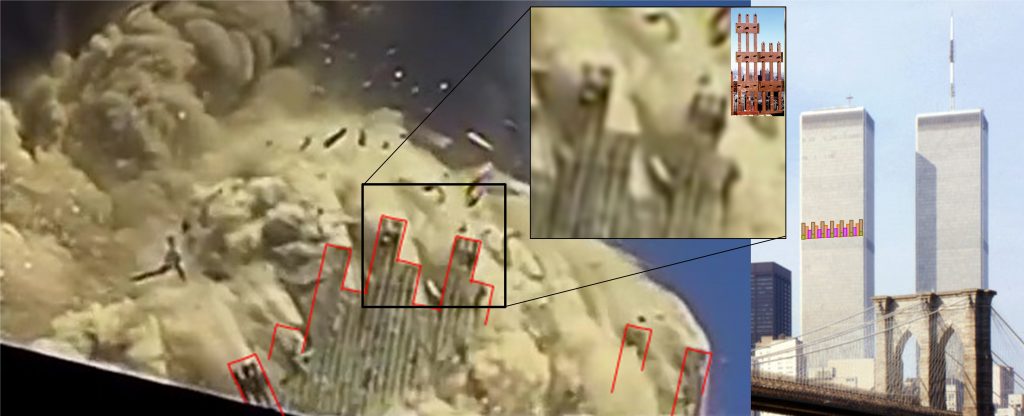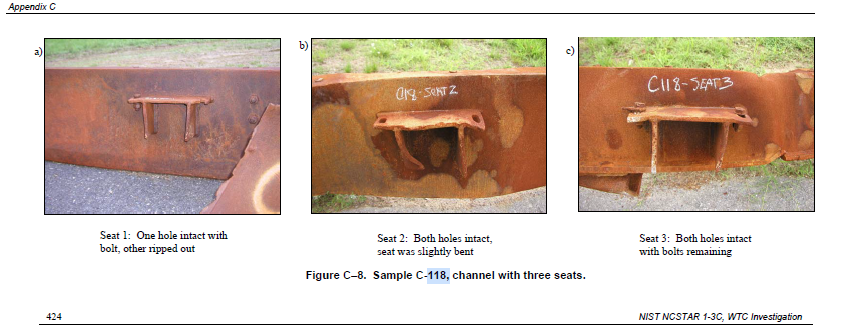The following two papers provide a detailed engineering assessment of the destruction of the Twin Towers.
The first paper describes an analysis showing that most of the perimeter columns in the east face of the South Tower are relatively intact, traveling at approximately 80 ft/sec (25 m/sec) away from its initial location and in free fall. The dynamics of this movement, several hundred feet from its initial location, cannot be explained by a gravity-only collapse subsequent to structural trauma by the aircraft and the subsequent fires.
The second paper identifies a structural weakness that allowed the Towers to be destroyed in a manner consistent with the above observation. The weakness that led to the destruction was a design that could not resist the unexpected outward forces that were applied to the perimeter walls. These forces caused the bolts between floor trusses and the core channel steel attached to the core structure to break. As a wall section on one floor was subjected to outward forces, the subsequent mechanical forces of the leaning perimeter columns leveraged the potential energy to create additional outward forces that would continue breaking additional bolts and/or cause necking (stretching like taffy) of the floor truss chords themselves. This mechanism explains the “unzipping” of the Tower outwardly in all directions.
Unlike the Bazant non-analysis that was the subject of the paper that was not allowed to be presented at SEFI 2015, these two papers provides a competent analysis of the observations before developing a suitable hypothesis.

Destruction of the WTC South Tower on 9/11: Analysis of Perimeter Column Trajectory Reveals Mechanism of Demolition
The exact mechanism of destruction of the Twin Towers on 9/11 has been discussed, at an cursory level, for the last 19 years. Because of outwardly directed energetic forces, a gravity-only collapse subsequent to fires is not supported by the observations. Analysis of the trajectory of a wall of perimeter columns from the South Tower provide a clear example of how the Towers were destroyed by a “Propelled Demolition” mechanism.
http://censoredbysefi.org/Analysis/Perimeter_Columns_of_the_South_Tower_Surfing_the_Big_Wave.pdf

Why Were the WTC Twin Towers Destroyed That Way: Explaining the Mechanism of Their Destruction on 9/11
One of the unanswered questions about the events of September 11, 2001, is why the Twin Towers were destroyed in such an energetically outward manner. The primary reason for this mode of demolition was the ability to exploit the structural weakness of the floor truss to channel connection requiring the breaking of a limited number of 5/8″ bolts per floor. A nano-thermite propellant could have provided the needed outward force.
http://censoredbysefi.org/Analysis/WTC_Propelled_Demolition_Paper.pdf
The following paper is about ethics and was presented at the “2014 IEEE International Symposium on Ethics in Engineering, Science and Technology”
Ethics and the Official Reports about the Destruction of the World Trade Center Twin Towers (WTC1 and WTC2) on 9/11: A Case Study
Ethics and the Official Reports about the Destruction of the World Trade Center Twin Towers (WTC1 and WTC2) on 9/11: A Case Study, by John D. Wyndham, Wayne H. Coste and Michael R. Smith, 2014 IEEE International Symposium on Ethics in Engineering, Science and Technology.
http://censoredbysefi.org/Analysis/IEEE_Ethics_Paper_030714.pdf
See also the poster for the paper presentation in Chicago, May 23-24, 2014.